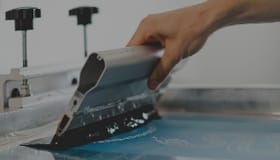Product overview
INQ-HF(LV)series is environmentally friendly 2 pack type ink series for film insert molding that does not intentionally use halogen compounds(chlorine Cl, bromine Br)in raw materials and reduces polycyclic hydrocarbons(PAHs)such as naphthalene to 500 ppm or less. INQ-HF(LV)series forms a printed ink layer with excellent flexibility and shows good adhesion to TPU particularly.
- Solvent type ink

Application
- Film insert products in general such as automobile interior, home appliance nameplates, and membrane switches.
Features, Function
- Two pack type ink, forms a printed ink layer with excellent flexibility and heat resistance.
- Create decoration printed materials for film insert molding on easy adhesion treated PET film and PC (polycarbonate) sheet.
- By combining with IMB binder, insert molding with PMMA, ABS, PC resins, etc. is possible.
- Forming, workability
- Electrical properties
- Multi color setting
- Halogen Free
- PAHs Free
- Low VOC
Substrate
- TPU, Easy adhesion treated PET film, PC sheet
- PC
- Easy adhesion treated PET
- TPU
Dilution
- C-002 SOLVENT (fast dry), C-003 SOLVENT (standard), C-004 SOLVENT (slow)
- Dilution 15%
- *Do not use other solvents as they may cause contamination of halogen compounds and PAHs, and may adversely affect curing, adhesion, stencil stability, or other properties.
Catalyst, Promoter mixing
- 210 Catalyst 3% (standard) Pot life 4 to 5 hrs.
- 106 Catalyst 4% (to improve adhesion to materials)Pot life 4 to 5 hrs.
- 240 Catalyst 3% (to improve heat resistance) Pot life 2 to 3 hrs.
- *The ink will turn to gel after the pot life has expired. Be sure to mix only enough to use
Promoter
- SM-40 DEFOAMER 1 to 3% (For anti-foam and improving leveling)
Recommended cleaner
- NF-003 SOLVENT
Mesh
- T 200 to 350 mesh(Coverage would be about 35m2/kg at 250 mesh)
Drying
- 90℃ 60 min *Ensure sufficient drying
- Overprints
Each layer 80℃ 10 min(tack-free)
Final layer 90℃ 60 min
Standard colors
-
HF(LV)001 VICTORIA
-
HF(LV)169 SCARLET
-
HF(LV)199 RED
-
HF(LV)249 LIGHT YELLOW
-
HF(LV)269LIGHT YELLOW
-
HF(LV)399 BLUE
-
HF(LV)529 ORANGE
-
HF(LV)589 MAGENTA
-
HF(LV)679 OPAQUE WHITE
-
HF(LV)829 VIOLET
-
HF(LV)979 BLACK
Caution
- Do not use solvents and catalysts other than the designated ones because of the possibility of contamination with halogen compounds and PAHs.
- Please check the squeegee rubber, emulsion, materials and substrates before use, as they may contain halogen compounds.
- Be sure to print a binder as an adhesion layer to the molding resin.
⇒IMB-HF009 Binder: Compatible with MIR ink, PC resin and PMMA resin molding.
⇒IMB-HF006 Binder: Compatible with general-purpose resin molding such as ABS, PMMA, As, etc.. - When printing a binder, if the underlayer ink is excessively dry, peeling strength will be reduced. Be sure to print continuously up to the binder and conduct final drying.
- In the forming process such as vacuum forming, pressure air forming, and mold forming, as well as in insert molding processes that integrate injection molded resin, a complex set of factors affect the performance of the final product, including the selection of printing materials and inks for design printing, printing conditions, printing sequence, drying method and conditions, selection of molding resin, mold design (gate shape, type and position, number of gates), and conditions set during injection molding.
- Please conduct sufficient tests on trial production and set up each condition appropriately before use.
- Ink shelf life: 36 months from production date, unopened
Safety
- UN No.: Not classified in the definition
- UN Classification: Not classified in the definition
Handling
- Use safety gloves and eyeglasses to protect skin and eyes. If the ink comes in contact with skin, wash with soap and plenty of water (or lukewarm water) and consult with a doctor.
- Containers should be closed tightly after use and stored in a cool and dark place.
- SDS is available upon request. Please request a copy and read it carefully before handling the products.
Resistance
| Test item | Test conditions | Test results |
|---|---|---|
| Adhesion | JIS K 5600-5-6:ISO2409(Cross-cut method),1mm interval 6×6, cellophane tape & peel | 0(no peel) |
| Pencil hardness | JIS K 5600-5-4:ISO 15184(pencil), weight 750g, Pencil hardness (Mitsubishi Uni pencil) which does not make scars. | B |
| Heat | JIS K5600-6-3:ISO 3248: 90℃, 400h, Check appearance and peel off from the substrate | No defect |
| Hot water | JIS K 5600-6-2: ISO 2812-2, Soak 48 hrs. in 50℃ warm water, Check appearance and peel off from the substrate. | No defect |
| Acid | Soak 7 hrs. in 5% H2SO4 Check appearance and peel off from the substrate. | No defect |
| Alkali | Soak 7 hrs. in 5% NaOH, Check appearance and peel off from the substrate | No defect |
| Alcohol | Gakushin scrub tester, cotton soaked ethanol, 200g weight, 50 back and forth, check peel off | No defect |
| Scrub | Gakushin scrub tester, cotton soaked ethanol, 500g weight, 500 back and forth, check color fade | No defect |
| Falling weight test | JIS K5600-5-3 DuPont Impulse tester, Drop 500g weight from 50 cm height, check appearance | No defect |
| Punching | Cut with a press machine, check cut edges. | No defect |
Test Condition
- Test condition 【INQ-HF(LV)679 WHITE】 【210 CATALYST 3%】 【C-003 SOLVENT 15%】 【90℃ 60 min】 【T 250】 【Substrate: Polycarbonate sheet (Panlite)】
- Above resistance test results are measured results in our laboratory and they are not guaranteed values.
- Information contained in this catalog may change without prior notice.
FAQ
-
What is the meaning of FIM/IMD?
-
The abbreviations, FIM and IMD, stand for Film Insert Molding and In-Mold Decoration. For these methods, the printed film is set into the mold and molded with molding resin as the finished product.
We recommend reading the FIM/IMD technology White Paper:
(1) FIM/IMD – 3 Process stages & Benefits
(2) FIM/IMD – Screen printing process –
(3) FIM/IMD – Forming process –
(Final) FIM/IMD – Injection process –We recommend reading the following reports:
Environmentally Friendly FIM/IMD Ink and Binder
IMB-HF006 Binder (Halogen Free, Environmentally Friendly Binder for IMD/FIM)
IPX-HF Screen Ink (2 Pack Halogen Free Environmentally Friendly Ink for IMD/FIM)
2 Pack Ink for FIM/IMD Applications
Adding High Value to Products with FIM/IMD (Part 3)
Adding High Value to Products with FIM/IMD (Part 2)
Adding High Value to Products with FIM/IMD (Part 1)
Teikoku Provides New Color and New Function to Plastic Products
FIM/IMD Technique: FIM Ink Design Technique,Optimization Technique of Forming Conditions -
Using FIM/IMD method, can you give us some examples of substrate film and molding resin combinations?
-
PC, PET, and Acrylic substrate sheets are suitable. Suitable resins are PC, PMMA, PC/ABS, AS, etc. However, PP and Olefin are currently difficult to use because they do not have good adhesiveness to the substrate materials.
-
What is the difference between Film Insert Molding and In Mold Decoration? Do you use different inks for each?
-
For the FIM method, the printed surface will be placed between the substrate sheet and the resin. On the other hand, for IMD method, the printed surface will appear on top of the adhered layer of the substrate sheet and the resin. The type ink will depend on the application and your requirements.
-
What is the largest size that you can use for the Insert Molding Method?
-
Theoretically, it depends on the capability of molding machine. However, there is an elongation limit of the substrate sheet; it varies depending on the printing materials you are using.
-
Can you give some examples of the type of industry where a combination of ink and molding method is being used? What would be the actual finished product?
-
The main industries will be automobile interiors, amusements, and home appliances. Their finished products are such items as speedometers, pinball game machines, water boilers, TVs and possibly as cover material in various other areas.
-
Do you have any restrictions when you use functional inks for molding inks?
-
There are some limitations of color hue, glossiness, and other properties. Sometimes, Teikoku Inks is unable to meet a customer’s requirements due to the design of the product.
-
We found that sometimes when we peel off the print from the injected resin, ink remains on one side or sometimes on both sides. Why does this occur?
-
In the case of ink remaining on the substrate, adhesion to the injected resin is poor. When ink remains on the injected resin, the adhesion to the substrate is poor. This is delamination. When ink remains on both sides, adhesion to substrate and injected resin are good, but the cohesion of the ink layer is poor. This is a cohesion failure.
-
The printed layer peeled away from the injected resin. What should we do?
-
This may be due to a mismatch of ink, substrate and the resin. Please contact our representative.
-
We have always had good adhesion, but suddenly peeling has occurred. What should we do?
-
Ink attached so far but it suddenly peeled off. I don’t know what to do.
Please check the following.
(1) Film thickness of printed ink layer
Thinner binder layer tends to have weaker adhesion.
(2) Drying conditions for printed ink layer
If ink doesn’t dry sufficiently, the strength of the printed ink layer becomes weak and cohesive fracture will occur.
(3) Are there any additives such as defoamer contained in ink or binder?
If additive such as defoamer is added in ink, ink’s adhesion to resin tends to be weak. -
What are the meanings of X and Q used in the ink names such as IPX, INQ, FMX, etc.?
-
X and Q are used to designate isophorone-free inks.
-
What is non-conductive black ink?
-
Non-Conductive Black Ink is an ink that has a high electrical resistance of the printed ink layer, and has both a function that is difficult for electricity to pass through and a high opaque black color. The high electrical resistance (low conductivity) prevents malfunctions and failures of electronic components, etc., caused by electric current flowing through the printed ink layer. Furthermore, its high opacity makes it suitable for printing on flat panels and smartphone displays that require light-shielding properties.
Related Link
Introduction of Functional Black Ink
- Related technical information
- Related event information

